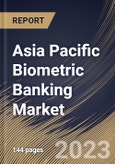The uniqueness of human biometric characteristics makes them resistant to imitation, thereby enhancing the security and reliability of biometric-based authentication. Moreover, biometric authentication appeals to tech-savvy consumers who value innovative and cutting-edge solutions. The use of biometrics attracts tech-savvy individuals and positions banks as progressive institutions.
The accessibility of reliable internet access and the rapid adoption of interconnected devices in manufacturing industries also contribute to the market's growth. Significant R&D investments are being made to improve the required connectivity to the network infrastructure, which supports market shares. In addition, smart devices and IoT in the retail sector enable businesses to improve the customer experience and increase conversions by modifying day-to-day store operations and expanding managed services.
The use of biometric technology in the banking industry in the Asia Pacific region has gained significant traction in recent years, driven by several factors and needs. With the increasing sophistication of cybercriminals and the rise in online and mobile banking, banks in the Asia Pacific are adopting biometrics to enhance security and protect customer data. Many countries in the Asia Pacific region have diverse populations, including many individuals who may not have easy access to traditional banking services. Biometric authentication can enable financial institutions to reach unbanked or underbanked people by providing them with secure and convenient access to banking services through biometric identity verification.
The China market dominated the Asia Pacific Biometric Banking Market, by Country in 2022, and would continue to be a dominant market till 2030; thereby, achieving a market value of $1,332.6 Million by 2030. The Japan market is registering a CAGR of 16.6% during (2023 - 2030). Additionally, The India market would showcase a CAGR of 18.1% during (2023 - 2030).
Based on Type, the market is segmented into Fingerprint, Facial Recognition, Hand Geometry, Iris Recognition and Others. Based on Vertical, the market is segmented into Retail, Transportation, Hospitality, Government, Healthcare and Others. Based on Component, the market is segmented into Hardware, Software and Services. Based on countries, the market is segmented into China, Japan, India, South Korea, Singapore, Malaysia, and Rest of Asia Pacific.
The market research report covers the analysis of key stake holders of the market. Key companies profiled in the report include Google LLC, NEC Corporation, Apple, Inc., The Charles Schwab Corporation, Mastercard Inc., Barclays Plc, Visa Inc., PayPal Holdings, Inc., Samsung Electronics Co. Ltd. and Aliph Brands.
Scope of the Study
Market Segments Covered in the Report:
By Type- Fingerprint
- Facial Recognition
- Hand Geometry
- Iris Recognition
- Others
- Retail
- Transportation
- Hospitality
- Government
- Healthcare
- Others
- Hardware
- Software
- Services
- China
- Japan
- India
- South Korea
- Singapore
- Malaysia
- Rest of Asia Pacific
Key Market Players
List of Companies Profiled in the Report:
- Google LLC
- NEC Corporation
- Apple, Inc.
- The Charles Schwab Corporation
- Mastercard Inc.
- Barclays Plc
- Visa Inc.
- PayPal Holdings, Inc.
- Samsung Electronics Co. Ltd.
- Aliph Brands
Unique Offerings
- Exhaustive coverage
- The highest number of Market tables and figures
- Subscription-based model available
- Guaranteed best price
- Assured post sales research support with 10% customization free
Table of Contents
Companies Mentioned
- Google LLC
- NEC Corporation
- Apple, Inc.
- The Charles Schwab Corporation
- Mastercard Inc.
- Barclays Plc
- Visa Inc.
- PayPal Holdings, Inc.
- Samsung Electronics Co. Ltd.
- Aliph Brands
Methodology

LOADING...








